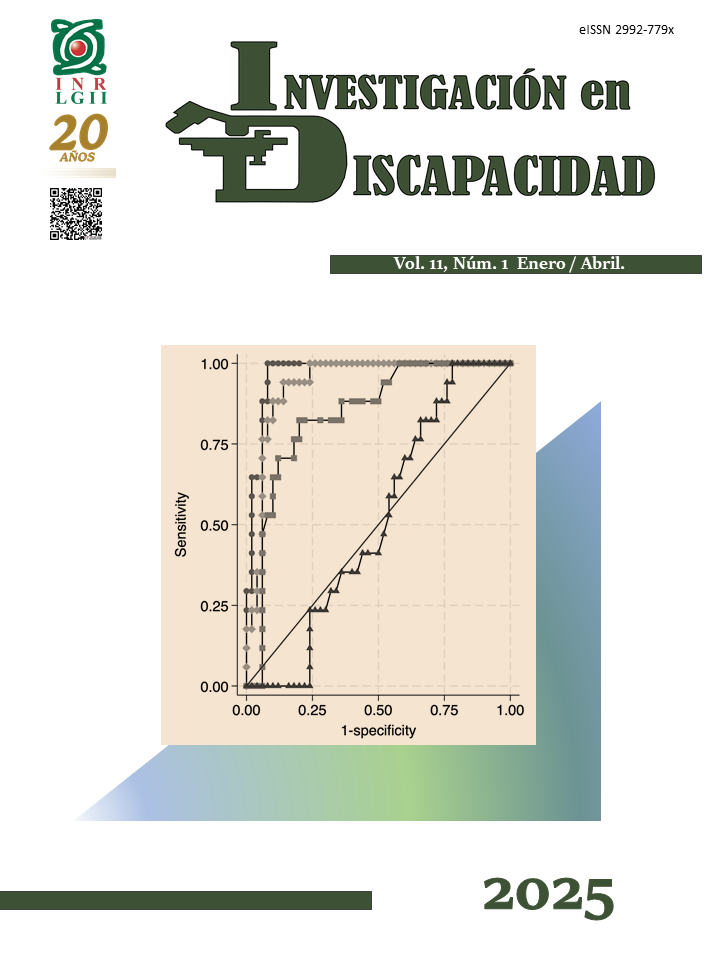Estudio del microsatélite Rep-1 del gen alfa sinucleina en pacientes con la enfermedad de Parkinson idiopática
DOI:
https://doi.org/10.35366/120411Palabras clave:
Enfermedad de Parkinson, gen alfa-sinucleina, microsatélite Rep-1Resumen
Introducción: La búsqueda de un biomarcador para el diagnóstico de la enfermedad de Parkinson (EP) es crucial para la prevención de la discapacidad. En el gen alfa sinucleina (α-Syn), se ha identificado un dinucleótido de tipo microsatélite denominado Rep-1 que podría ser utilizado como un biomarcador de riesgo en la EP. Objetivo: fue el estudio de las variantes del microsatélite Rep-1 del gen α-Syn en pacientes con la EP. Material y Métodos: Se realizó un estudio de casos y controles, donde se reclutaron 30 pacientes en el Instituto Nacional de Rehabilitación. Posteriormente se les tomó una muestra de sangre periférica para la extracción de ADN genómico, la genotipificación de los repetidos dinucleótidos se realizó en un secuenciador de ADN ABI PRISM 3500xL. Los datos se compararon con una t-student y para las variables cualitativas se utilizó una χ2, para obtener una probabilidad de riesgo. Resultados: 15 pacientes con diagnóstico de la EP, fueron 10 (66.7%) mujeres y 5 (33.3%) hombres, con una edad promedio de 65 ± 6.36. Las variantes del gen α-Syn más frecuentes fueron de 265 pb con el 63.3% y la variante 267 pb con el 20% en ambos grupos. Existe una mayor significancia de los alelos más largos con los pacientes con EP con una probabilidad de riesgo 1.37 y una p = 0.09. Conclusión: La identificación del microsatélite Rep-1 del gen α-Syn está mostrando una tendencia de los alelos de mayor tamaño (>265 pb) como un factor de riesgo para presentar la EP idiopática.
##plugins.generic.pfl.publicationFactsTitle##
##plugins.generic.pfl.reviewerProfiles## N/D
##plugins.generic.pfl.authorStatements##
Indexado: {$indexList}
-
##plugins.generic.pfl.indexedList##
- ##plugins.generic.pfl.academicSociety##
- N/D
Citas
Bibliografía
- Morris HS, Spillantini MG, Sue CM, and Williams-Gray CH. The pathogenesis of Parkinson´s disease. Lancet 2024; 403(10423): 293-304.
- Lee A., Gilbert RM. Epidemiology of Parkinson disease. Neurol Clin 2016; 34: 955-965.
- Schapira AHV., Chaudhuri KR., and Jenner P. Non-motor features of Parkinson disease. Nat Rev Neurosci 2017; 18(7): 435-450.
- Sauerbier A., Jenner P., Todorova A., Chaudhuri KR., Non motor subtypes and Parkinson´s disease. Parkinsonism Relat Disord 2016; 22 Suppl 1:S41-S46.
- Kalia LV., Lang AE. Parkinson´s disease. Lancet 2015; 386: 896-912.
- Lees AJ., Hardy J and Revez T. Parkinson´s disease. Lancet 2009; 373:2055-2066.
- Shahmoradian SH., Lewis AJ., Genoud C., Hench J., Moors TE., Navarro PP., et al. Lewy pathology in Parkinson´s disease consists of crowded organelles and lipid membranas. Nat Neurosci 2019; 22(7): 1099-1109.
- Tolosa E., Garrido A., Scholz SW., and Poewe W. Challenges in the diagnosis of Parkinson´s disease. Lancet Neurol 2021; 20(5): 385-397.
- Jankovik J., and Tan EK. Parkinson´s disease: etiopathogenesis and treatment. J Neurol Neurosurg Psychiatry 2020; 91(8): 795-808.
- Correia Guedes L., Mestre T., Outeiro TF., and Ferreira JJ. Are genetic and Idiopathic formo f Parkinson´s disease the same disease?. J Neurochem 2020; 152(5):515-522.
- Stefanis L. α-Synuclein in Parkinson´s disease. Cold Spring Harb perspect Med 2012; 2(2):a 009399.
- Tofaris GK. Initiation and progression of Alpha-synuclein pathology in Parkinson´s disease. Cell Mol Life Sci 2022; 79(4):210.
- Henderson MX., Trojanowski JQ., Lee VM. Alpha-synuclein pathology in Parkinson´s disease and related Alpha synucleinopathies. Neurosci lett 2019; 709: 134316.
- Kim S., Jeon BS., Heo C., Im PS., Ahn TB., Seo JH., et al. Alpha-synuclein induces apoptosis by altered expresion in human peripheral lymphocyte in Parkinson´s disease. FASEB J 2004; 18(13): 1615-1617.
- Winkler S., Hagenah J., Lincoln S., Heckman M., Haugarvoll K., Lohmann-Hedrich K., et al. Alpha-Synuclein and Parkinson disease susceptibility. Neurology 2007; 69(18):1745-1750.
- Pals P., Lincoln S., Manning J., Heckman M., Skipper L., Hulihan M., et al. Alpha synuclein promoter confers susceptibility to Parkison´s disease. ANN Neurol 2004; 56(4):591-595.
- Hoehn MM., Yahr MD. Parkinsonism: onset, progression, and mortality. Neurology 1967; 17(5): 427-442.
- Yong AC., Tan YJ., Zhao Y., Lu Z., Ng EY., Ng SY., et al. SNCA Rep 1 microsatellite length influences no-motor symptoms in early Parkinson´s disease. Aging 2020; 12(20):20880-20887.
- Beitz JM. Parkinson´s disease: a review. Front Biosci 2014; 6: 65-74.
- Sherer TB., Betarbet R., Greenamyre JT. Pathogenesis of Parkinson´s disease. Curr Opin Invest Drugs 2001; 2: 657-662.
- Xia Y., Rohan de Silva HA., Rosi BL., Yamamoto LH., Rimmler JB., Pericak-Vance MA., et al. Genetic studies in Alzheimer´s disease with an NACP/Alpha-synuclein polymorphism. Ann Neurol 1996; 40:207-215.
- Brighina L., Schneider NK., Lesnick TG., de Andrade M., Cunningham JM., Mrazek D., et al. Alpha-synuclein, alcohol use disorders, and Parkinson disease: a case-control study. Parkinsonism Relat Disord 2009; 15: 430-434.
- Spadafora P., Annesi G., Pasqua AA., Serra P., Ciro Candiano IC., Carrideo S., et al. NACP-REP1 polymorphism is not involved in Parkinson´s disease: a case-control study in a population sample from southern italy. Neurosci Lett 2003; 351: 75-78.
- Gatto NM., Rhodes SL., Manthripragada AD., Bronstein J., Cockburn M., Farrer M., et al. Alpha-synuclein gene may interact with environmental factors in increasingrisk of Partkinson´s disease. Neuroepidemiology 2010; 35:191-195.
- Iakovenko EV., Abramycheva N., Fedotova E., and Illarioshkin SN. The SNCA-Rep1 polimorphic Locus: Association with the Risk of Parkinson´s Desease and SNCA Gene Methylation. Acta Naturae 2020; 12(2): 105-110.
- Linnertz C., Saucer L., Ge D., Cronin KD, Burke JR., Browndyke JN., Et al. Genetic regulation of Alpha-synuclein mRNA expresión in various human brain tissues. PLoS One 2009; 4(10): e7480.
- Fuchs J., Tichopad A., Golub Y., Munz M., Schweitzer KJ., Wolf B. et al. Faseb J 2008;22(5): 1327-1334.
- Cronin KD., Ge D., Manninger P., Linnertz C., Rossoshek A., Orrison BM., et al. Expansion of the Parkinson disease-associated SNCA-Rep1 allele upregulates human Alpha-synuclein in trasgenic mouse brain. Hum Mol Genet 2009; 18(17): 3274-3285.
- Zhang N., Yan Z., Xin H., Shao S., Xue S., Cespuglio R. et al. Relationship among α-synuclein, aging and inflammation in Parkinson´s disease. Exp Ther Med 2023; 27(1): 1-16.
- Coleman C and Martin I. Unraveling Parkinson´s disease neurodegeneration: Does aging hold the clue?. Parkinsons Dis 2022; 12(8): 2321-2338.
- Hou Y., Dan X., Babbar M., Wei Y., Hasselbalch SG., Croteau DL., et al. Ageing as a risk factor for neurodegenerative disease. Nat Rev Neurol 2019; 15(10):565-581.
- Patel R and Kompoliti K. Sex and gender differences in Parkinson´s disease. Neurol Clin 2023; 41(2): 371-379.
- Cerri S., Mus L and Blandini F. Parkinson´s disease in women and Men: What´s the difference?. J Parkinsons Dis 2019; 9(3): 501-515.
- Huang X., Chen H., Miller WC., Mailman RB., Woodard JL., Chen PC., et al. Lower low-density lipoprotein colesterol levels are associated with Parkinson´s disease. Mov Disord 2007; 22:377-381.
- Huang X., Abbott RD., Petrovitch H., Mailman RB., and Ross GW. Low LDL colesterol and increased risk of Parkinson´s disease: prospective results from Honolulu-Asia aging study. Mov Disord 2008; 23:1013-1018.
- Nam GE., Kim SM., Ha K., Kim NH., Chung HS., Kim JW., et al. Metabolic síndrome and risk of Parkinson disease: a nationwide cohort study. PLos Med 2018; 15:e1002640.
- de Lau LM., Koudstaal PJ., Hofman A., and Breteler MM. Serum colesterol level and the risk of Parkinson´s disease. Am J Epidemiol 2006; 164:998-1002.
- Huang X., Alonso A., Gou X., Umbach DM., Lichtenstein ML., Ballantyne CM., et al. Statins, plasma colesterol, and risk of Parkinson´s disease: a prospective study. Mov Disord 2015; 30:552-559.
Descargas
Publicado
Cómo citar
Número
Sección
Licencia
Derechos de autor 2024 Instituto Nacional de Rehabilitación Luis Guillermo Ibarra Ibarra

Esta obra está bajo una licencia internacional Creative Commons Atribución 4.0.
© Instituto Nacional de Rehabilitación Luis Guillermo Ibarra Ibarra under a Creative Commons Attribution 4.0 International (CC BY 4.0) license which allows to reproduce and modify the content if appropiate recognition to the original source is given.




